by Bruce Wells | Aug 1, 2023 | Petroleum Transportation
Bertha Benz’s 65-mile drive in 1888 made headlines for her husband’s fledgling auto company.
German mechanical engineer Karl Friedrich Benz invented and built a three-wheel “motorwagen,” today recognized as the world’s first car. His wife helped steer the company’s first marketing campaign.
Although others had experimented with electric and steam-powered vehicles — and a gasoline powered engine had been added to a pushcart in 1870 — it is was Karl Benz who invented the modern car when he built his “Fahrzeug mit Gasmotorenbetrieb” (vehicle with gas engine) in Mannheim, Germany, in 1885.
Born in 1844 in Baden Muehlburg, Benz had founded an “Iron Foundry and Machine Shop” in 1871. He received his first engine patent eight years later.
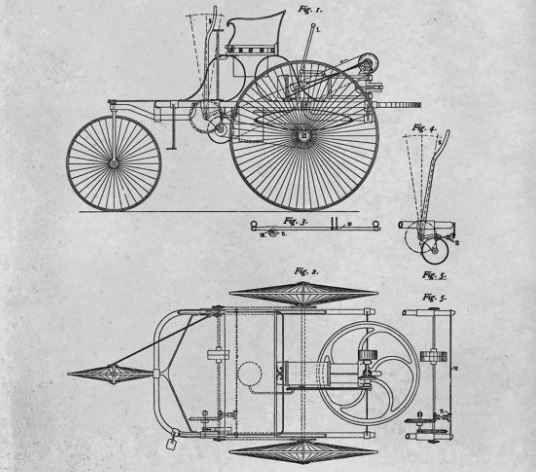
Detail from “Vehicle with Gas Engine Operation,” patent No. 37435, submitted by Karl Benz on January 29, 1884, at the Reich Patent Office in Berlin.
On January 29, 1886, Benz applied for an Imperial patent for his three-wheeled carriage powered by a one-cylinder, four-stroke gasoline engine. Reich Patent No. 37435 has been referred to as the birth certificate of the automobile.
Benz’s design is recognized as the world’s first for a practical internal combustion engine powered automobile.

Although there had already been “auto-mobiles,” Benz’s first car used the internal combustion engine as the drive system for a “self-mover,” notes a Mercedes Benz company historian. “He presented his stroke of genius at the Imperial Patent Office – the car was born.”
Because he would quickly build several identical three-wheeled vehicles, Benz also has been credited with the first “production car” in history.

Bertha Benz in August 1888 became the first person to drive her husband’s “motorwagen” over a long distance; her publicity stunt brought wide attention…and sales.
Benz’s original 1886 engine – with a displacement of 0.954 of a liter – anticipated design elements still found in modern internal combustion engines, including a crankshaft with balance weights, electric ignition, and water cooling (generating 0.55 kW and a top speed of 16 km/h, virtually corresponding to the power of one horse).
It would not be long before his wife — from a wealthy German family who had earlier used her dowry to help Benz — made headlines driving his new automobile.
Bertha’s Publicity Stunt
Thirty-nine-year-old Bertha Benz made history on August 12, 1888, when she became the first person to complete a long-distance trip by automobile. She followed wagon tracks on a trip that popularized Karl Benz’s latest invention and reportedly saved him from financial ruin.
Bertha drove away with the “Model III Patent Motorwagen” without her husband’s permission, although she left a note saying she was taking their 13 and 15-year-old sons to visit her mother in Pforzheim. Her route from their home in Mannheim was about 65 miles, one-way.

The soon widely publicized drive, which included stops at apothecary shops to buy a petroleum solvent needed keep the car running, took about 15 hours. She returned home three days later.
“The value of the journey to the fledgling car company that would in time become Mercedes-Benz is hard to quantify properly, but she surely helped to ensure that by the end of the century it was the largest car company in the world,” concluded a 2013 article in The Telegraph.
“Bertha’s journey proved many things, not least that a woman was every bit as capable of handling one of these newfangled contraptions as a man,” the article also noted. “Today you can go to Mannheim and retrace her steps by following the signs of the Bertha Benz Memorial Route.”

Karl Benz’s wife Bertha was the first person to drive his gas-powered motorwagen over a long distance — bringing worldwide attention. Map courtesy Bertha Benz Memorial Route.
According to Mary Bellis in her 1903 “Biography of Karl Benz,” Benz retired from Benz & Company after his engine designs became outdated by inventions by Gottlieb Daimler.

Daimler (together with his design partner Wilhelm Maybach) in 1885 had taken the internal combustion engine “a step further and patented what is generally recognized as the prototype of the modern gas engine,” noted Bellis.
Karl Benz would serve as a member of the supervisory board of Daimler-Benz AG from 1926, when the company was formed, until his death in 1929. Bertha Benz was inducted into the Automotive Hall of Fame in 2016 as the first female automotive pioneer.
In America, Charles Duryea claimed the first U.S. patent for a gasoline automobile in 1895. One year later, Henry Ford sold his first “quadri-cycle,” creating the auto industry. By the turn of the century, about 8,000 vehicles shared mostly unpaved roads with horses and wagons.
The first U.S. auto show took place in November 1900 in New York City, where public workers annually removed 450,000 tons of horse manure from streets. America’s highways and travel history are on exhibit at the National Museum of American History’s America on the Move.
_______________________
Recommended Reading: Bertha Takes a Drive: How the Benz Automobile Changed the World (2017). Your Amazon purchase benefits the American Oil & Gas Historical Society. As an Amazon Associate, AOGHS earns a commission from qualifying purchases.
(2017). Your Amazon purchase benefits the American Oil & Gas Historical Society. As an Amazon Associate, AOGHS earns a commission from qualifying purchases.
_______________________
The American Oil & Gas Historical Society (AOGHS) preserves U.S. petroleum history. Join today as an AOGHS annual supporting member. Help maintain this energy education website and expand historical research. For more information, contact bawells@aoghs.org. Copyright © 2024 Bruce A. Wells. All rights reserved.
Citation Information – Article Title: “First Car, First Road Trip.” Authors: B.A. Wells and K.L. Wells. Website Name: American Oil & Gas Historical Society. URL: https://aoghs.org/transportation/benz-patents-first-car. Last Updated: August 1, 2023. Original Published Date: September 15, 2015.
by Bruce Wells | Jun 30, 2023 | Petroleum Transportation
19th century coopers made wooden barrels of all capacities, including hogsheads, puncheons, tierces, butts, and tuns.
Soon after America’s first commercial oil well of 1859, a small group met in northwestern Pennsylvania and decided a 42-gallon barrel was best for transporting their oil.
When filled with oil instead of fish or other commodities, a 42-gallon “tierce” weighed 300 pounds. The 42-gallon oil barrel was officially adopted in 1866. Today, a barrel’s refined products include about 20 gallons of gasoline, 12 gallons of diesel and four gallons of jet fuel (and rocket fuel) and other products like liquefied petroleum gases and asphalt.

By the 1860s, barges floated barrels of oil down the Allegheny River to Pittsburgh to be refined into a highly demanded product – kerosene for lamps. Image from an early oil company stock certificate.
In August 1866 a handful of America’s earliest independent oil producers met in Titusville, Pennsylvania, and agreed that henceforth, 42 gallons would constitute a barrel of oil. Pennsylvania led the world in oil production as demand soared for kerosene lamp fuel. (more…)
by Bruce Wells | Jun 13, 2023 | Petroleum Transportation
North Slope oil began moving through Alaska’s 800-mile pipeline system in 1977.
The Trans-Alaska Pipeline System, designed and constructed to carry billions of barrels of North Slope oil to the port of Valdez, has been recognized as a landmark of engineering. On June 20, 1977, the 800-mile pipeline began carrying oil from Prudhoe Bay oilfields to the Port of Valdez at Prince William Sound. The oil began arriving 38 days later.
In July 1973, a tie-breaking vote by Vice President Spiro Agnew in the U.S. Senate had passed the Trans-Alaska Pipeline Authorization Act after years of debate about the pipeline’s environmental impact. Concerns included spills, earthquakes, and elk migrations.
With the laying of the first section of pipe on March 27, 1975, construction began on what at the time was the largest private construction project in American history.
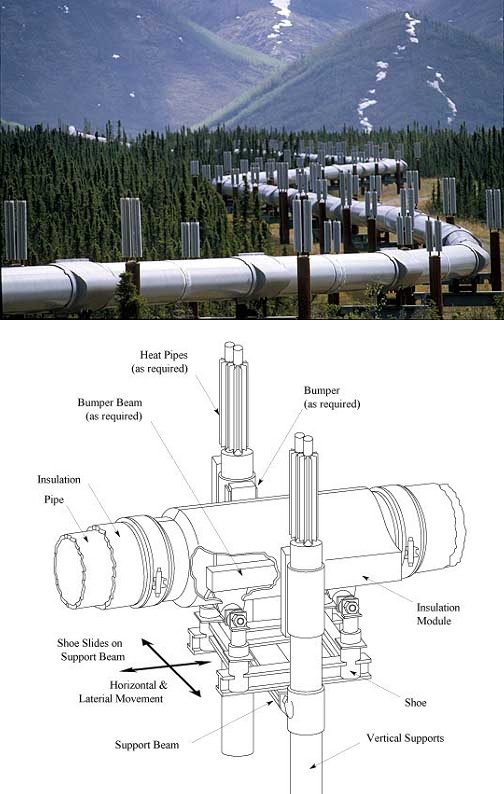
The Alaskan Pipeline system’s 420-miles above ground segments are built in a zig-zag configuration to allow for expansion or contraction of the pipe.
The 800-mile Trans-Alaska Pipeline system, including pumping stations, connecting pipelines, and the ice-free Valdez Marine Terminal, ended up costing billions. The last pipeline weld was completed on May 31, 1977.
On June 20, 1977, oil from the North Slope’s Prudhoe Bay field began flowing to the port of Valdez at four miles an hour through the 48-inch-wide pipe. It arrived at the port eight days later.

The completed pipeline system, at a cost of $8 billion, including terminal and pump stations, will transport about 20 percent of U.S. petroleum production. Tax revenues alone earned Alaskans about $50 billion by 2002.
Engineering Milestones
Special engineering was required to protect the environment in difficult construction conditions, according to Alyeska Pipeline Service Company. Details about the pipeline’s history include:
- Oil was first discovered in Prudhoe Bay on the North Slope in 1968.
- Alyeska Pipeline Service Company was established in 1970 to design, construct, operate and maintain the pipeline.
- The state of Alaska entered into a right-of-way agreement on May 3, 1974; the lease was renewed in November of 2002.
- Thickness of the pipeline wall: .462 inches (466 miles) & .562 inches (334 miles).
- The Trans-Alaska Pipeline System cross the ranges of the Central Arctic heard on the North Slope and the Nelchina Herd in the Copper River Basin.
- The Valdez Terminal covers 1,000 acres and has facilities for crude oil metering, storage, transfer and loading.
- The pipeline project involved some 70,000 workers from 1969 through 1977.
- The first pipe of the Trans-Alaska Pipeline System was laid on March 27, 1975. Last weld was completed May 31, 1977.
- The pipeline is often referred to as “TAPS” – an acronym for the Trans Alaska Pipeline System.
- More than 170 bird species have been identified along the pipeline.
- First oil moved through the pipeline on June 20, 1977.
- 71 gate valves can block oil flow in either direction on the pipeline.
- First tanker to carry crude oil from Valdez: ARCO Juneau, August 1, 1977.
- Maximum daily throughput was 2,145,297 on January 14, 1988.
- The pipeline is inspected and regulated by the State Pipeline Coordinator’s Office.
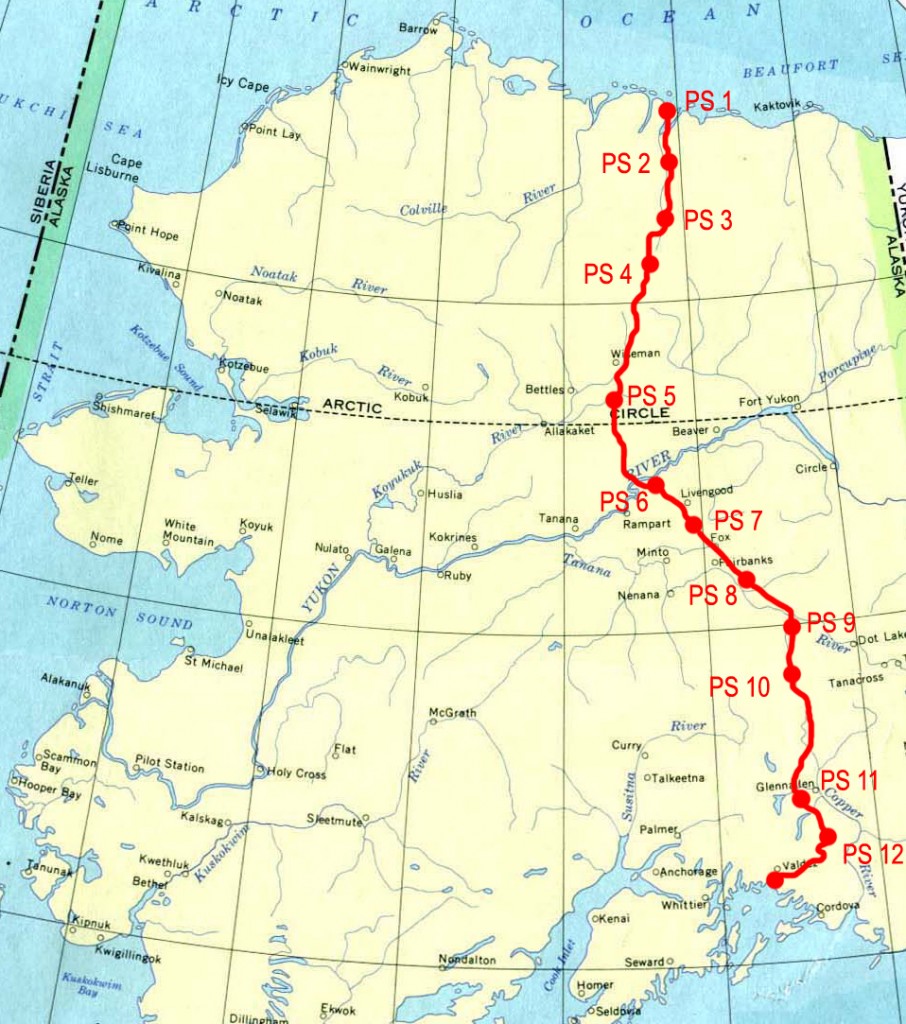
The Alaskan pipeline brings North Slope production to tankers at the port of Valdez. Map courtesy USGS.
At the peak of its construction in the fall of 1975, more than 28,000 people worked on the pipeline. There were 31 construction camps built along the route, each built on gravel to insulate and help prevent pollution to the underlying permafrost.
The above-ground sections of the pipeline (420 miles) were constructed in a zigzag configuration to allow for expansion or contraction of the pipe because of temperature changes.

Specially designed anchor structures, 700 feet to 1,800 feet apart, securely hold the pipe in position. In warm permafrost and other areas where heat might cause undesirable thawing, the supports contain two, two-inch pipes called “heat pipes.”

The Trans-Alaska Pipeline today has been recognized as a landmark engineering feat. It remains essential to Alaska’s economy.
The first tanker carrying North Slope oil from the new pipeline sailed out of the Valdez Marine Terminal on August 1, 1977. By 2010, the pipeline had carried about 16 billion barrels of oil. Alaska’s total oil production in 2013 was nearly 188 million barrels, or about seven percent of total U.S. production.
Oil Production Rise and Fall
The first Alaska oil well with commercial production was completed in 1902 in a region where oil seeps had been known for years. The Alaska Steam Coal & Petroleum Syndicate produced the oil near the remote settlement of Katalla on Alaska’s southern coastline. The oilfield there also led to construction of Alaska Territory’s first refinery.
Atlantic Richfield (ARCO) and Exxon discovered the Prudhoe Bay field in March 1968 about 250 miles north of the Arctic Circle. The oilfield proved to be the largest in North America at more than 213,500 acres (exceeding the East Texas Oilfield, discovered in 1930).
Alaska oil production peaked in 1988 at 738 million barrels of oil, about 25 percent of U.S. oil production, according to the Energy Information Administration (EIA). In 2020, oil production reached the lowest level in more than 40 years.
“Crude oil production in Alaska averaged 448,000 barrels per day (b/d) in 2020, the lowest level of production since 1976,” the agency noted in its April 2021 Today in Energy report. “Last year’s production was over 75 percent less than the state’s peak production of more than 2 million b/d in 1988.”

The decline in the state’s oil production has decreased deliveries in the Trans-Alaska Pipeline System, EIA added. “Lower oil volumes cause oil to move more slowly in the pipeline, and the travel time for oil from the North Shore to Valdez has increased from 4.5 days in 1988 to 18 days in 2020.”
For America’s pipeline history during the World War Two, see Big Inch Pipelines of WW II and PLUTO, Secret Pipelines of WWII.
_______________________
Recommended Reading: The Great Alaska Pipeline (1988); Amazing Pipeline Stories: How Building the Trans-Alaska Pipeline Transformed Life in America’s Last Frontier
(1988); Amazing Pipeline Stories: How Building the Trans-Alaska Pipeline Transformed Life in America’s Last Frontier (1997); Oil and Gas Pipeline Fundamentals
(1997); Oil and Gas Pipeline Fundamentals (1993); Oil: From Prospect to Pipeline
(1993); Oil: From Prospect to Pipeline (1971). Your Amazon purchase benefits the American Oil & Gas Historical Society. As an Amazon Associate, AOGHS earns a commission from qualifying purchases.
(1971). Your Amazon purchase benefits the American Oil & Gas Historical Society. As an Amazon Associate, AOGHS earns a commission from qualifying purchases.
_______________________
The American Oil & Gas Historical Society (AOGHS) preserves U.S. petroleum history. Become an AOGHS annual supporting member and help maintain this energy education website and expand historical research. For more information, contact bawells@aoghs.org. © 2023 Bruce A. Wells.
Citation Information – Article Title: “Trans-Alaska Pipeline History.” Author: Aoghs.org Editors. Website Name: American Oil & Gas Historical Society. URL: https://aoghs.org/transportation/trans-alaska-pipeline. Last Updated: June 12, 2023. Original Published Date: June 20, 2015.
by Bruce Wells | May 20, 2023 | Petroleum Transportation
Powered by an railroad diesel-electric engine in 1934, a “Streamliner” cut steam locomotion time by half.
By the early 1930s, America’s passenger railroad business was in deep trouble. In addition to the Great Depression, the once dominant transportation industry faced growing competition from automobiles. New U.S. refineries produced vast amounts of gasoline, thanks to giant oilfield discoveries like Spindletop Hill in Texas.
Primitive diesel engines of the day remained heavy and slow. The railroad diesel-electric engine was in the future.
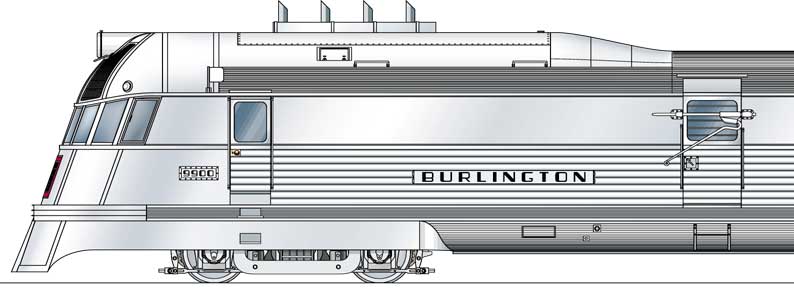
Diesel-electric engines pioneered by General Motors and Winton Engine Company saved America’s railroad passenger industry. Two-stroke diesel engines provided a four-fold power to weight gain. Photo courtesy Model Railroader magazine, January 1999.
It had been just 60 years since coal-burning steam locomotives and the transcontinental railroad had linked America’s east and west coasts on May 10, 1869. Despite the hard economic times, gasoline powered more than 30 million cars, trucks, and buses on U.S. roads (many without asphalt paving). But what would power heavy transportation?
“Once I built a railroad, I made it run, made it race against time. Once I built a railroad; now it’s done. Brother, can you spare a dime?” — Bing Crosby, 1932.
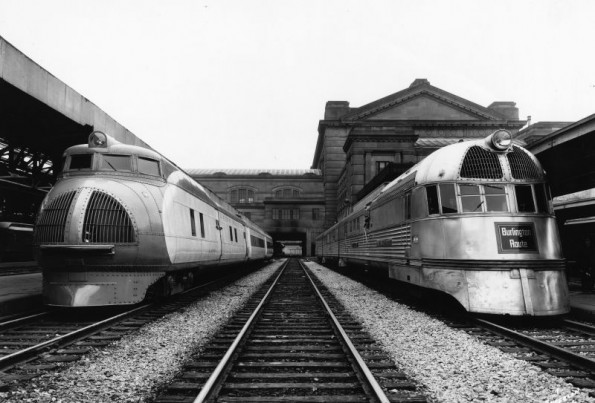
The two “streamliner” trains that changed America’s railroad industry in the late 1930s: the Union Pacific M-10000 (left) and Burlington Zephyr. Today the Zephyr is on display at the Chicago Museum of Science and Industry. Photo courtesy Union Pacific Museum.
Although railroad steam engine technology had advanced since the “golden spike” of 1869 in Promontory Point, Utah, locomotives still “belched steam, smoke, and cinders,” noted one railroad historian, adding “Passengers often felt like they had been on a tour of a coal mine.”

While most locomotives were still steam-powered, General Electric built America’s first commercially successful gasoline-powered engine locomotive in 1913. Two 175-horsepower V-8s powered two 600-volt, direct current generators to propel the 57-ton locomotive to a top speed of 51 miles per hour.

Diesel engines had been used since about 1925. The engines were heavy, producing only a single horsepower from 80 pounds of engine weight.
The Electric Line of Minnesota Company purchased this new gas-powered electric hybrid for $34,500 and named it “Dan Patch” in honor of the world’s champion harness horse of the time. It would not be long before diesel engines with electric generators would transform train travel.
Primitive diesels had been used in switch engines from about 1925, but they were slow, according to Richard Cleghorn Overton in Burlington Route: A History of the Burlington Lines. But the railroads’ distillate-burning internal combustion engines proved heavy and difficult to maintain.

The powerful diesel-electric Zephyr arrived in 1934; its technology was a result of the Navy’s search for an improved submarine engine.
Burning fuels ranged from a low-grade gasoline to painter’s naphtha and diesel. Distillate railroad engines emitted an oily smoke and often produced only a single horsepower from 80 pounds of engine weight. These common four-stroke engines fouled easily and required multiple spark plugs per cylinder.
Help for America’s failing passenger railroads would come from U.S. Navy diesel-electric engine technology, wrapped in a stainless steel Art Deco locomotive.

New diesel-electric engines generated power for the “Making of a Motor Car” exhibit at the 1933 Century of Progress fair in Chicago. The assembly line fascinated visitors who watched from overhead galleries.
“Wings to the Iron Horse…Burlington pioneers again — the first diesel streamline train,” proclaimed passenger rail advertisements in the 1930s. The long awaited technology for railroad diesel-electric engines had arrived.
Railroad Diesel-Electric Engines
With the Nazi threat and war on the horizon, the U.S. Navy needed a lighter weight, more powerful diesel engine for its submarine fleet. The Navy also recognized it had been too slow converting its surface vessels from coal to fuel oil (see Petroleum and Sea Power).
General Motors joined the nationwide competition to develop a new diesel engine for the Navy.
Seeking engineering and production expertise, in 1930 GM acquired the Winton Engine Company of Cleveland, Ohio. Winton, established in 1896 as Winton Bicycle Company, was an early automobile manufacturer. Winton Engine Company evolved into a developer of engines for marine applications, power companies, pipeline operators — and railroads.
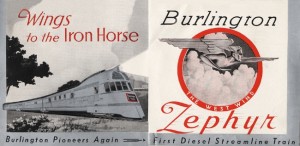
America’s first diesel-electric train, the Burlington Zephyr, was a transportation milestone.
With GM’s financial backing, Winton engineers designed a radical new two-stroke diesel that delivered one horsepower per 20 pounds of engine weight. It provided a four-fold power to weight gain.

The Model 201A prototype — a 503-cubic-inch, 600 horsepower, 8-cylinder diesel-electric engine — used no spark plugs, relying instead on newly patented high pressure fuel injectors and a 16:1 compression ratio for ignition.

Powered by an eight-cylinder Winton 201A diesel engine, the revolutionary “streamliner” traveled the 1,015 miles from Denver to Chicago in just over 13 hours — a passenger train record.
At Chicago’s Century of Progress World’s Fair in 1933, GM evaluated two railroad diesel-electric engines, using them to generate power for its “Making of a Motor Car” exhibit. The working demonstration of a Chevrolet assembly line fascinated thousands of visitors who watched from overhead galleries.
One visitor happened to be Ralph Budd, president of the Chicago, Burlington & Quincy Railroad (known as the Burlington Line). Budd recognized the locomotive potential of these extraordinary new diesel-electric power plants. He saw them as a perfect match for the lightweight “shot-welded” stainless steel rail cars pioneered by the Edward G. Budd (no relation) Manufacturing Company in Philadelphia.
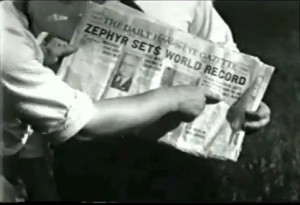
During its “dawn to dusk” record-breaking run, the Zephyr burned only $16.72 worth of diesel fuel.
Edward Budd was the first to supply the automobile industry with all steel bodies in 1912. His success in steel stamping technology made the production of car bodies cheaper and faster. By 1925, his system was used to produce half of all U.S. auto bodies.
The Depression, however, put the Budd Manufacturing Company almost $2,000,000 in the red — prompting its fortuitous diversification into the railroad car market to generate revenue. When approached by Burlington President Ralph Budd in 1933, this Budd was ready.
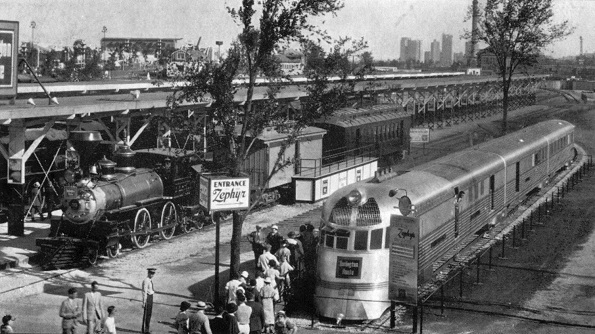
Chicago World’s Fair visitors line up to admire the stainless steel beauty of the Burlington Zephyr, which will soon be featured in a Hollywood movie. Eight major U.S. railroads soon convert to efficient diesel-electric locomotives. Photo from a Burlington Route Railroad 1934 postcard.
Within a year, the two technologies were successfully merged with the creation of the Winton 201A powered Burlington Zephyr, America’s first diesel-electric train. It would change railroad transportation history.
Art Deco Silver Streak
The Zephyr rolled into Chicago’s Century of Progress exhibition on May 26, 1934, ending a nonstop 13 hour, 4 minute, and 58 second “dawn to dusk” promotional run from Denver.
Powered by a single eight-cylinder Winton 201A diesel, the “streamliner” cut average steam locomotive time by half. The Zephyr traveled 1,015 miles at an average speed of 76.61 miles per hour and reached speeds along the route in excess of 112 mph — to the amazement and delight of track-side spectators from Colorado to Illinois.
During its record-breaking run, the Zephyr burned just $16.72 worth of diesel fuel (about four cents per gallon). The same distance in a coal steamer would have cost $255. Construction innovations included the specialized shot-welding that joined sheets of stainless steel.
The lightweight steel also resisted corrosion so it didn’t have to be painted.
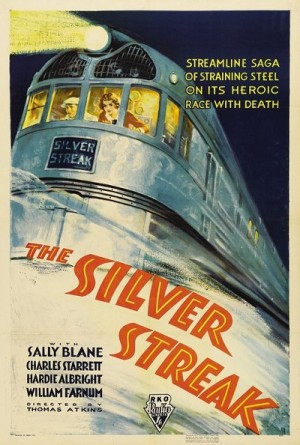
Although ”The Silver Streak” was a 1934 “B” movie — intended for the bottom half of double features — it remains a favorite of some railroad history fans.
Americans fell in love with the Zephyr. Four months after its high-speed appearance at Chicago’s Century of Progress, the streamliner made its 1934 Hollywood film debut, starring as “The Silver Streak” for an RKO picture.
The Zephyr was loaned for filming — and the Burlington logo on its front was repainted to read Silver Streak. “The stream-lined train, platinum blonde descendant of the rugged old Iron Horse, has been glorified by Hollywood in the modern melodrama,” proclaimed the New York Times.
Although the black-and-white “B” movie came and went without making much of a splash, it has won its place in movie history as a rail-fan favorite, according to a 2001 article in the Zephyr Online. “It did have a lot of action, and the location shots of the Zephyr are an interesting record of this pioneer.”

The RKO film should not to be confused with 20th Century Fox’s 1976 comedy “Silver Streak,” which was filmed in Canada using Canadian Pacific Railway equipment from the Canadian, a transcontinental passenger train.
WWII Submarine Power
By the end of 1934, eight major U.S. railroads had ordered diesel-electric locomotives. The engine technology’s cost advantages in manpower, maintenance, and support were quickly apparent.
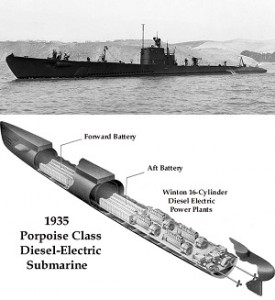
Winton diesel-electric engines powered a new generation of U.S. submarines. The Porpoise (SS-172) was the first of its class to join the fleet in 1935 — and served throughout World War II..
Despite the greater initial cost of diesel-electric, a century of steam locomotive dominance soon came to an end. By the mid-1950s, steam locomotives were no longer being manufactured in the United States.
GM won the Navy’s competition for a lightweight powerful diesel — choosing the 16-cylinder Winton Engine Company diesel-electric to power a new class of submarine. In 1935, the USS Porpoise was first to join the fleet, where it served throughout World War II. Diesel-electrics power plants descended from the Burlington Zephyr would remain part of the fleet until replaced by nuclear propulsion.
A Zephyr competitor — the Union Pacific M-10000 built by the Pullman Car & Manufacturing Company — also showcased railroad diesel-electric engine technology at the Century of Progress World’s Fair in Chicago.
In fact, the aluminum M-10000 streamliner was revealed six weeks earlier than the Zephyr. Recognized as America’s first streamliner, the M-10000 was cut up for scrap in 1942. The Zephyr (later renamed the Pioneer Zephyr) ended up on display at the Chicago Museum of Science and Industry.
_______________________
Recommended Reading: Burlington’s Zephyrs, Great Passenger Trains (2004); The Great Railroad Revolution: The History of Trains in America
(2004); The Great Railroad Revolution: The History of Trains in America (2013). Your Amazon purchase benefits the American Oil & Gas Historical Society. As an Amazon Associate, AOGHS earns a commission from qualifying purchases.
(2013). Your Amazon purchase benefits the American Oil & Gas Historical Society. As an Amazon Associate, AOGHS earns a commission from qualifying purchases.
_______________________
The American Oil & Gas Historical Society (AOGHS) preserves U.S. petroleum history. Become an AOGHS annual supporting member and help maintain this energy education website and expand historical research. For more information, contact bawells@aoghs.org. © 2023 Bruce A. Wells.
Citation Information – Article Title: “Adding Wings to the Iron Horse.” Authors: B.A. Wells and K.L. Wells. Website Name: American Oil & Gas Historical Society. URL: https://aoghs.org/transportation/adding-wings-to-the-iron-horse. Last Updated: May 21, 2023. Original Published Date: April 29, 2014.
by Bruce Wells | Nov 21, 2022 | Petroleum Transportation
From kerosene to gasoline, an 1892 Wayne Oil Tank & Pump Company dispenser preserves petroleum history.
Wayne D. Lease of White Salmon, Washington, owns an 1892 self-measuring pump designed to dispense kerosene. His pump was one of just 50 manufactured by the Wayne Oil Tank & Pump Company during its first year of business in Wayne, Indiana. Lease, who has researched pump’s manufacturing history, owns the rare petroleum technology artifact.
Originally designed for selling kerosene at mercantile stores, the Wayne company self-measuring pump was later adapted for dispensing gasoline instead of kerosene, according to its current owner.

Original 1892 Wayne Oil Tank Company pump, one of just 50 manufactured to dispense kerosene during the company’s first year of business in Wayne, Indiana.
“My research indicates the Wayne pump was never manufactured to be used for gasoline, but rather kerosene only,” Lease noted in a December 2020 email to the American Oil & Gas Historical Society.

He explained that many researchers of gasoline service station pumps have overlooked Wayne and other manufacturers’ altered pumps, “best defined as an ‘after strike,’ which allowed the use in the transfer of the more volatile gasoline.”
Self-measuring pump venders made good use of a dispenser that had become less needed because of electric lighting, Lease added.
The original Wayne Oil Tank & Pump Company design was limited to the specific use of kerosene as a lamp fuel, Lease explained. Kerosene was sold in the general stores of rural America, where stores were often found at stage coach stops 15 miles to 25 miles apart.
Kerosene lamp fuel would be joined by a new transportation fuel in the early 1900s, gasoline for autos. “Small cities now become the hub of commerce on a larger scale with the introduction of the combustion engine,” he added. Kerosene would succumb to the Rural Electrification Act (1936) as gasoline became the U.S. consumer’s primary need.
“The Wayne pump, one of fifty made in1892, was then certified for the use of the transfer of Gasoline, and the vender made good use of what had become obsolete,” the amateur pump historian concluded in his 2020 email to AOGHS. He continues to research more information about the pump.
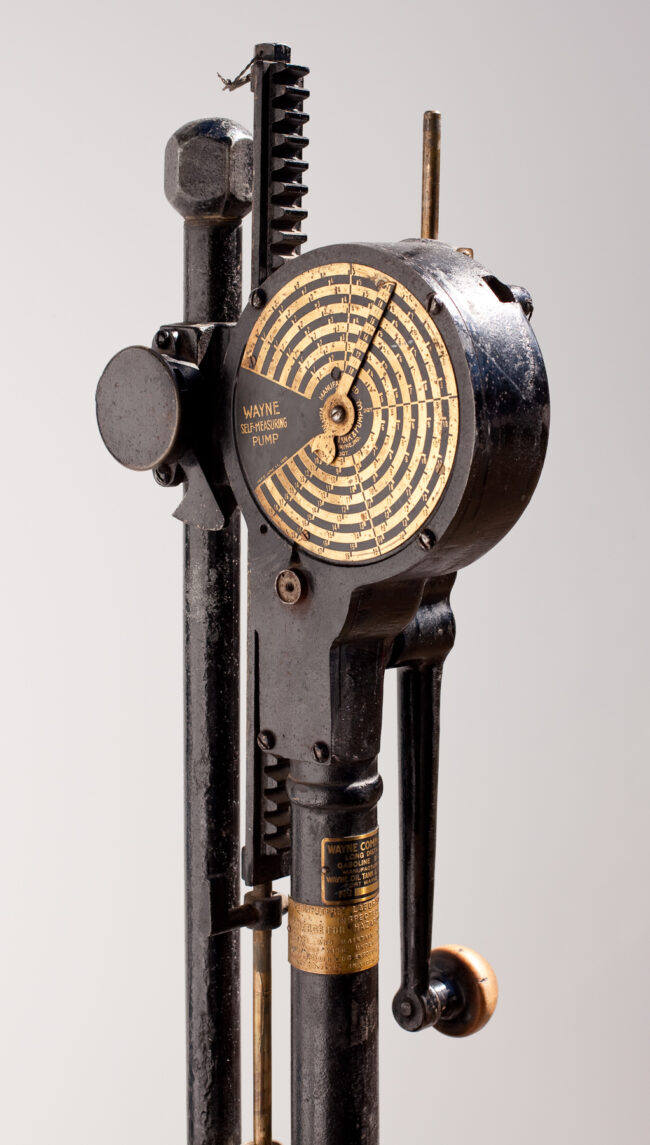
Detailed Wayne pump measurement scale for accurate dispensing of kerosene and later, gasoline.
“It is in immaculate condition as you can see by the photographs, Lease noted in his email to AOGHS. He is seeking more information about the pump…and a potential petroleum museum interested in adding the Wayne pump to its collection. Comments are welcomed below.

Learn more early transportation and gasoline pump history in First Gas Pump and Service Station and Coin-Operated Gas Pumps.
Wayne Fueling Systems
History from the former Wayne Oil Tank Company, today still operating as Wayne Fueling Systems:
Wayne has been shaping the retail and fleet fueling industry since we designed our first pump in 1891. We were known as the Wayne Oil Tank Company back then, and from the very beginning we were developing a reputation for quality.
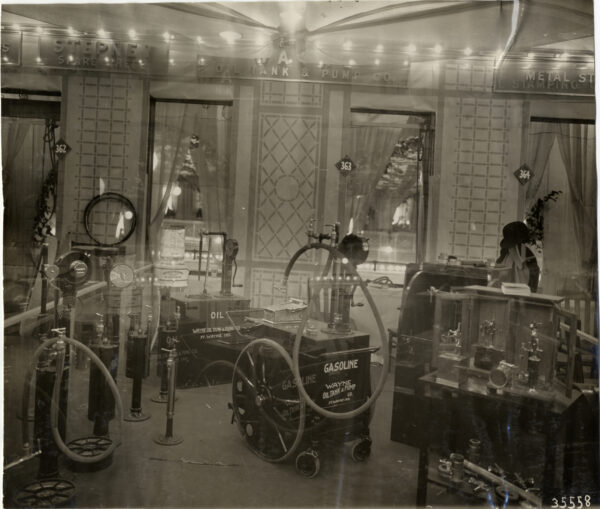
Trade show display for Wayne Oil Tank and Pump Company equipment, showing gasoline and oil pumps. Sign for Wayne Oil Tank & Pump Co. in background. Handwritten note on back: “Service stations, 1910. Gasoline pump.” Photo courtesy Detroit Public Library.
In fact, this inaugural product won the distinction “The Best Self Measuring Oil Pump” at the Columbian Exposition in Chicago just two years later. Once the motor vehicle entered the scene, our purpose and mission was solidified – to create a reliable, accurate way for motorists to refuel cars...Learn more at About Wayne Fueling Systems.
_______________________
Recommended Reading: Pump and Circumstance: Glory Days of the Gas Station (1993). Your Amazon purchase benefits the American Oil & Gas Historical Society. As an Amazon Associate, AOGHS earns a commission from qualifying purchases.
_______________________
The American Oil & Gas Historical Society preserves U.S. petroleum history. Become an AOGHS annual supporting member and help maintain this energy education website and expand historical research. For more information, contact bawells@aoghs.org. Copyright © 2022 Bruce A. Wells. All rights reserved.
Citation Information – Article Title: “Oil Riches of Merriman Baptist Church.” Authors: B.A. Wells and K.L. Wells. Website Name: American Oil & Gas Historical Society. URL: https://aoghs.org/oil-almanac/oil-riches-of-merriman-baptist-church. Last Updated: March 11, 2022. Original Published Date: July 14, 2021.



(2017). Your Amazon purchase benefits the American Oil & Gas Historical Society. As an Amazon Associate, AOGHS earns a commission from qualifying purchases.





















